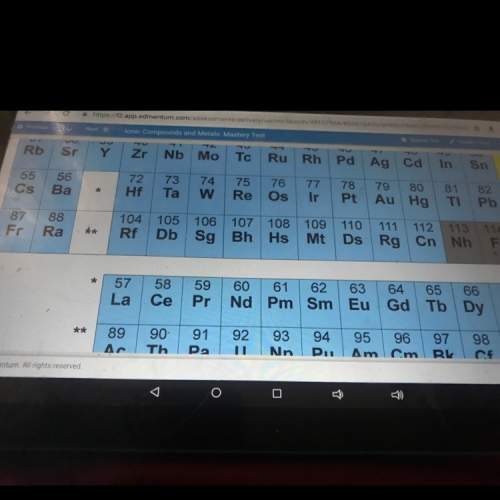
Chemistry, 14.09.2019 08:20 jesussanchez1445
Consider the equilibrium for the vapor pressure of br2(): k 0.29 br2()br2(g) if a 1.0 l container has 1.00 bar of br2(g) and 3.45 mol of br2(0), what will happen? the excess br: (g) will condense to form br2() until equilibrium is established. b. the excess br2(g) will evaporate to form br2() until equilibrium is established. c. the rate of condensation will be equal to the rate of evaporation since the mixture is at dynamic equilibrium and no change will be observed. d. the excess br20) will evaporate to form br2(g) until equilibrium is established. e. the excess br: 0) will condense to form bra() until equilibrium is established. a. 3. out of the following list of group iv hydrides (ch4, sih4, geh, snha) predict which liquid will have the greatest surface tension with the best explanation: a. ch4) because ch ) has intermolecular hydrogen-bonding b. sih4(i) because sih4(i) has the greatest dipole-dipole intermolecular forces. c. geh) because geh4(l) has the greatest dipole-dipole intermolecular forces. d. snh4() because snh4() has the greatest dispersion intermolecular forces. e. they should all have the same surface tension because they are all in group iv sublimes, a 4. when a this phase change is converts to a (ii) when the intermolecular forces(v) (ii) because energy is (iv) (v) form (i) (iv) absorbed liquid endothermic endothermic solid liquid exothermic solid a. solid b. absorbed released gas break break c. d. solid gas exothermic released form solid exothermic released form gas 5. at 25°c, glass (sio2) does not have a regular arrangement of its atoms. thus glass is an a. crystalline ionic compound. b. amorphous ionic compound. c. crystalline network covalent solid. d. amorphous network covalent solid. crystalline molecular solid. example of a(n): e. 1.00 g of chromium (lii) chloride (crcls) is dissolved in 100 ml of pure water at 25°c. what is the resulting ph with the best corresponding reason? a. the ph-7 because chromium(iii) and chloride are neutral ions b. the ph> 7 because chromium(iii) is a neutral cation and chloride is a weak brønsted base. c. the ph> 7 because chromium(ii) is a weak brønsted acid and chloride is a strong brønsted base. d. the ph

Answers: 2


Another question on Chemistry

Chemistry, 21.06.2019 15:30
1. baking powder is a 1: 1 molar mixture of cream of tartar (khc4h4o6) and baking soda (nahco3). a recipe calls for two teaspoons (a total of 8.0 grams) of cream of tartar. how much baking soda must be added for both materials to react completely?
Answers: 2

Chemistry, 22.06.2019 04:30
How many grams of co(g) are there in 74.5 ml of the gas at 0.933 atm and 30o c?
Answers: 1

Chemistry, 22.06.2019 17:00
The msds for glacial acetic acid says that it is a flammable liquid that can severely burn any human tissue it comes in contact with. it reacts with bases, various metals, and strong oxidizing agents. its vapors can form explosive mixtures with air.
Answers: 1

Chemistry, 22.06.2019 21:30
How many liters of 3.0 m naoh solution will react with 0.60 liters of 4.0 m h2so4? h2so4 + naoh → na2so4 + h2o 1.2 l 1.6 l 2.4 l 2.8 l
Answers: 3
You know the right answer?
Consider the equilibrium for the vapor pressure of br2(): k 0.29 br2()br2(g) if a 1.0 l container h...
Questions



Law, 13.09.2019 00:30




Mathematics, 13.09.2019 00:30

Mathematics, 13.09.2019 00:30




Mathematics, 13.09.2019 00:30



Chemistry, 13.09.2019 00:30








